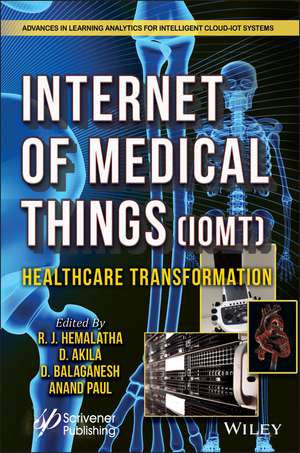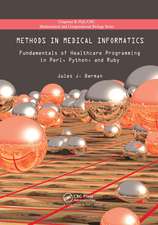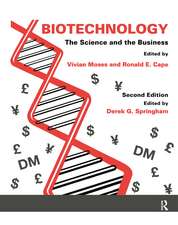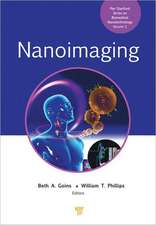The Internet of Medical Things (IoMT) – Healthcare Transformation: Advances in Learning Analytics for Intelligent Cloud-IoT Systems
Autor RJ Hemalathaen Limba Engleză Hardback – 28 mar 2022
Preț: 922.94 lei
Nou
Puncte Express: 1384
Preț estimativ în valută:
176.62€ • 191.79$ • 148.37£
176.62€ • 191.79$ • 148.37£
Carte disponibilă
Livrare economică 01-15 aprilie
Livrare express 15-21 martie pentru 41.15 lei
Preluare comenzi: 021 569.72.76
Specificații
ISBN-13: 9781119768838
ISBN-10: 1119768837
Pagini: 336
Dimensiuni: 152 x 229 x 17 mm
Greutate: 0.59 kg
Editura: Wiley
Seria Advances in Learning Analytics for Intelligent Cloud-IoT Systems
Locul publicării:Hoboken, United States
ISBN-10: 1119768837
Pagini: 336
Dimensiuni: 152 x 229 x 17 mm
Greutate: 0.59 kg
Editura: Wiley
Seria Advances in Learning Analytics for Intelligent Cloud-IoT Systems
Locul publicării:Hoboken, United States
Notă biografică
Audience This book will be suitable for a wide range of researchers who are interested in acquiring in-depth knowledge on the latest IoMT-based solutions for healthcare-related problems. The book is specifically for those in artificial intelligence, cyber-physical systems, robotics, information technology, safety-critical systems, digital forensics, and application domain communities such as critical infrastructures, smart healthcare, manufacturing, and smart cities. R.J. Hemalatha, PhD in Electronics Engineering from Sathyabama University, India. She is currently the Head of the Department of Biomedical Engineering, in Vels Institute of Science, Technology & Advanced Studies (VISTAS), Chennai, Tamil Nadu, India. She has published more than 50 research papers in various international journals. D. Akila, PhD received his degree in Computer Science from Bharathiar University, Tamilnadu, India. She is an associate professor in the Department of Information Technology, School of Computing Sciences, Vels Institute of Science, Technology & Advanced Studies (VISTAS), Chennai, Tamil Nadu, India. She has published more than 25 research papers in various international journals. D. Balaganesh, PhD is a Dean of Faculty Computer Science and Multimedia, Lincoln University College, Malaysia. Anand Paul, PhD is an associate professor in the School of Computer Science and Engineering, Kyungpook National University, South Korea. He received his PhD degree in Electrical Engineering from National Cheng Kung University, Taiwan, R.O.C. in 2010.
Cuprins
Preface xv
1 In Silico Molecular Modeling and Docking Analysis in Lung Cancer Cell Proteins 1
Manisha Sritharan and Asita Elengoe
1.1 Introduction 2
1.2 Methodology 4
1.2.1 Sequence of Protein 4
1.2.2 Homology Modeling 4
1.2.3 Physiochemical Characterization 4
1.2.4 Determination of Secondary Models 4
1.2.5 Determination of Stability of Protein Structures 4
1.2.6 Identification of Active Site 4
1.2.7 Preparation of Ligand Model 5
1.2.8 Docking of Target Protein and Phytocompound 5
1.3 Results and Discussion 5
1.3.1 Determination of Physiochemical Characters 5
1.3.2 Prediction of Secondary Structures 7
1.3.3 Verification of Stability of Protein Structures 7
1.3.4 Identification of Active Sites 14
1.3.5 Target Protein-Ligand Docking 14
1.4 Conclusion 18
References 18
2 Medical Data Classification in Cloud Computing Using Soft Computing With Voting Classifier: A Review 23
Saurabh Sharma, Harish K. Shakya and Ashish Mishra
2.1 Introduction 24
2.1.1 Security in Medical Big Data Analytics 24
2.1.1.1 Capture 24
2.1.1.2 Cleaning 25
2.1.1.3 Storage 25
2.1.1.4 Security 26
2.1.1.5 Stewardship 26
2.2 Access Control-Based Security 27
2.2.1 Authentication 27
2.2.1.1 User Password Authentication 28
2.2.1.2 Windows-Based User Authentication 28
2.2.1.3 Directory-Based Authentication 28
2.2.1.4 Certificate-Based Authentication 28
2.2.1.5 Smart Card-Based Authentication 29
2.2.1.6 Biometrics 29
2.2.1.7 Grid-Based Authentication 29
2.2.1.8 Knowledge-Based Authentication 29
2.2.1.9 Machine Authentication 29
2.2.1.10 One-Time Password (OTP) 30
2.2.1.11 Authority 30
2.2.1.12 Global Authorization 30
2.3 System Model 30
2.3.1 Role and Purpose of Design 31
2.3.1.1 Patients 31
2.3.1.2 Cloud Server 31
2.3.1.3 Doctor 31
2.4 Data Classification 32
2.4.1 Access Control 32
2.4.2 Content 33
2.4.3 Storage 33
2.4.4 Soft Computing Techniques for Data Classification 34
2.5 Related Work 36
2.6 Conclusion 42
References 43
3 Research Challenges in Pre-Copy Virtual Machine Migration in Cloud Environment 45
Nirmala Devi N. and Vengatesh Kumar S.
3.1 Introduction 46
3.1.1 Cloud Computing 46
3.1.1.1 Cloud Service Provider 47
3.1.1.2 Data Storage and Security 47
3.1.2 Virtualization 48
3.1.2.1 Virtualization Terminology 49
3.1.3 Approach to Virtualization 50
3.1.4 Processor Issues 51
3.1.5 Memory Management 51
3.1.6 Benefits of Virtualization 51
3.1.7 Virtual Machine Migration 51
3.1.7.1 Pre-Copy 52
3.1.7.2 Post-Copy 52
3.1.7.3 Stop and Copy 53
3.2 Existing Technology and Its Review 54
3.3 Research Design 56
3.3.1 Basic Overview of VM Pre-Copy Live Migration 57
3.3.2 Improved Pre-Copy Approach 58
3.3.3 Time Series-Based Pre-Copy Approach 60
3.3.4 Memory-Bound Pre-Copy Live Migration 62
3.3.5 Three-Phase Optimization Method (TPO) 62
3.3.6 Multiphase Pre-Copy Strategy 64
3.4 Results 65
3.4.1 Finding 65
3.5 Discussion 69
3.5.1 Limitation 69
3.5.2 Future Scope 70
3.6 Conclusion 70
References 71
4 Estimation and Analysis of Prediction Rate of Pre-Trained Deep Learning Network in Classification of Brain Tumor MRI Images 73
Krishnamoorthy Raghavan Narasu, Anima Nanda, Marshiana D., Bestley Joe and Vinoth Kumar
4.1 Introduction 74
4.2 Classes of Brain Tumors 75
4.3 Literature Survey 76
4.4 Methodology 78
4.5 Conclusion 93
References 95
5 An Intelligent Healthcare Monitoring System for Coma Patients 99
Bethanney Janney J., T. Sudhakar, Sindu Divakaran, Chandana H. and Caroline Chriselda L.
5.1 Introduction 100
5.2 Related Works 102
5.3 Materials and Methods 104
5.3.1 Existing System 104
5.3.2 Proposed System 105
5.3.3 Working 105
5.3.4 Module Description 106
5.3.4.1 Pulse Sensor 106
5.3.4.2 Temperature Sensor 107
5.3.4.3 Spirometer 107
5.3.4.4 OpenCV (Open Source Computer Vision) 108
5.3.4.5 Raspberry Pi 108
5.3.4.6 USB Camera 109
5.3.4.7 AVR Module 109
5.3.4.8 Power Supply 109
5.3.4.9 USB to TTL Converter 110
5.3.4.10 EEG of Comatose Patients 110
5.4 Results and Discussion 111
5.5 Conclusion 116
References 117
6 Deep Learning Interpretation of Biomedical Data 121
T.R. Thamizhvani, R. Chandrasekaran and T.R. Ineyathendral
6.1 Introduction 122
6.2 Deep Learning Models 125
6.2.1 Recurrent Neural Networks 125
6.2.2 LSTM/GRU Networks 127
6.2.3 Convolutional Neural Networks 128
6.2.4 Deep Belief Networks 130
6.2.5 Deep Stacking Networks 131
6.3 Interpretation of Deep Learning With Biomedical Data 132
6.4 Conclusion 139
References 140
7 Evolution of Electronic Health Records 143
G. Umashankar, Abinaya P., J. Premkumar, T. Sudhakar and S. Krishnakumar
7.1 Introduction 143
7.2 Traditional Paper Method 144
7.3 IoMT 144
7.4 Telemedicine and IoMT 145
7.4.1 Advantages of Telemedicine 145
7.4.2 Drawbacks 146
7.4.3 IoMT Advantages with Telemedicine 146
7.4.4 Limitations of IoMT With Telemedicine 147
7.5 Cyber Security 147
7.6 Materials and Methods 147
7.6.1 General Method 147
7.6.2 Data Security 148
7.7 Literature Review 148
7.8 Applications of Electronic Health Records 150
7.8.1 Clinical Research 150
7.8.1.1 Introduction 150
7.8.1.2 Data Significance and Evaluation 151
7.8.1.3 Conclusion 151
7.8.2 Diagnosis and Monitoring 151
7.8.2.1 Introduction 151
7.8.2.2 Contributions 152
7.8.2.3 Applications 152
7.8.3 Track Medical Progression 153
7.8.3.1 Introduction 153
7.8.3.2 Method Used 153
7.8.3.3 Conclusion 154
7.8.4 Wearable Devices 154
7.8.4.1 Introduction 154
7.8.4.2 Proposed Method 155
7.8.4.3 Conclusion 155
7.9 Results and Discussion 155
7.10 Challenges Ahead 157
7.11 Conclusion 158
References 158
8 Architecture of IoMT in Healthcare 161
A. Josephin Arockia Dhiyya
8.1 Introduction 161
8.1.1 On-Body Segment 162
8.1.2 In-Home Segment 162
8.1.3 Network Segment Layer 163
8.1.4 In-Clinic Segment 163
8.1.5 In-Hospital Segment 163
8.1.6 Future of IoMT? 164
8.2 Preferences of the Internet of Things 165
8.2.1 Cost Decrease 165
8.2.2 Proficiency and Efficiency 165
8.2.3 Business Openings 165
8.2.4 Client Experience 166
8.2.5 Portability and Nimbleness 166
8.3 loMT Progress in COVID-19 Situations: Presentation 167
8.3.1 The IoMT Environment 168
8.3.2 IoMT Pandemic Alleviation Design 169
8.3.3 Man-Made Consciousness and Large Information Innovation in IoMT 170
8.4 Major Applications of IoMT 171
References 172
9 Performance Assessment of IoMT Services and Protocols 173
A. Keerthana and Karthiga
9.1 Introduction 174
9.2 IoMT Architecture and Platform 175
9.2.1 Architecture 176
9.2.2 Devices Integration Layer 177
9.3 Types of Protocols 177
9.3.1 Internet Protocol for Medical IoT Smart Devices 177
9.3.1.1 HTTP 178
9.3.1.2 Message Queue Telemetry Transport (MQTT) 179
9.3.1.3 Constrained Application Protocol (CoAP) 180
9.3.1.4 AMQP: Advanced Message Queuing Protocol (AMQP) 181
9.3.1.5 Extensible Message and Presence Protocol (XMPP) 181
9.3.1.6 DDS 183
9.4 Testing Process in IoMT 183
9.5 Issues and Challenges 185
9.6 Conclusion 185
References 185
10 Performance Evaluation of Wearable IoT-Enabled Mesh Network for Rural Health Monitoring 187
G. Merlin Sheeba and Y. Bevish Jinila
10.1 Introduction 188
10.2 Proposed System Framework 190
10.2.1 System Description 190
10.2.2 Health Monitoring Center 192
10.2.2.1 Body Sensor 192
10.2.2.2 Wireless Sensor Coordinator/Transceiver 192
10.2.2.3 Ontology Information Center 195
10.2.2.4 Mesh Backbone-Placement and Routing 196
10.3 Experimental Evaluation 200
10.4 Performance Evaluation 201
10.4.1 Energy Consumption 201
10.4.2 Survival Rate 201
10.4.3 End-to-End Delay 202
10.5 Conclusion 204
References 204
11 Management of Diabetes Mellitus (DM) for Children and Adults Based on Internet of Things (IoT) 207
Krishnakumar S., Umashankar G., Lumen Christy V., Vikas and Hemalatha R.J.
11.1 Introduction 208
11.1.1 Prevalence 209
11.1.2 Management of Diabetes 209
11.1.3 Blood Glucose Monitoring 210
11.1.4 Continuous Glucose Monitors 211
11.1.5 Minimally Invasive Glucose Monitors 211
11.1.6 Non-Invasive Glucose Monitors 211
11.1.7 Existing System 211
11.2 Materials and Methods 212
11.2.1 Artificial Neural Network 212
11.2.2 Data Acquisition 213
11.2.3 Histogram Calculation 213
11.2.4 IoT Cloud Computing 214
11.2.5 Proposed System 215
11.2.6 Advantages 215
11.2.7 Disadvantages 215
11.2.8 Applications 216
11.2.9 Arduino Pro Mini 216
11.2.10 LM78XX 217
11.2.11 MAX30100 218
11.2.12 LM35 Temperature Sensors 218
11.3 Results and Discussion 219
11.4 Summary 222
11.5 Conclusion 222
References 223
12 Wearable Health Monitoring Systems Using IoMT 225
Jaya Rubi and A. Josephin Arockia Dhivya
12.1 Introduction 225
12.2 IoMT in Developing Wearable Health Surveillance System 226
12.2.1 A Wearable Health Monitoring System with Multi-Parameters 227
12.2.2 Wearable Input Device for Smart Glasses Based on a Wristband-Type Motion-Aware Touch Panel 228
12.2.3 Smart Belt: A Wearable Device for Managing Abdominal Obesity 228
12.2.4 Smart Bracelets: Automating the Personal Safety Using Wearable Smart Jewelry 228
12.3 Vital Parameters That Can Be Monitored Using Wearable Devices 229
12.3.1 Electrocardiogram 230
12.3.2 Heart Rate 231
12.3.3 Blood Pressure 232
12.3.4 Respiration Rate 232
12.3.5 Blood Oxygen Saturation 234
12.3.6 Blood Glucose 235
12.3.7 Skin Perspiration 236
12.3.8 Capnography 238
12.3.9 Body Temperature 239
12.4 Challenges Faced in Customizing Wearable Devices 240
12.4.1 Data Privacy 240
12.4.2 Data Exchange 240
12.4.3 Availability of Resources 241
12.4.4 Storage Capacity 241
12.4.5 Modeling the Relationship Between Acquired Measurement and Diseases 242
12.4.6 Real-Time Processing 242
12.4.7 Intelligence in Medical Care 242
12.5 Conclusion 243
References 244
13 Future of Healthcare: Biomedical Big Data Analysis and IoMT 247
Tamiziniyan G. and Keerthana A.
13.1 Introduction 248
13.2 Big Data and IoT in Healthcare Industry 250
13.3 Biomedical Big Data Types 251
13.3.1 Electronic Health Records 252
13.3.2 Administrative and Claims Data 252
13.3.3 International Patient Disease Registries 252
13.3.4 National Health Surveys 253
13.3.5 Clinical Research and Trials Data 254
13.4 Biomedical Data Acquisition Using IoT 254
13.4.1 Wearable Sensor Suit 254
13.4.2 Smartphones 255
13.4.3 Smart Watches 255
13.5 Biomedical Data Management Using IoT 256
13.5.1 Apache Spark Framework 257
13.5.2 MapReduce 258
13.5.3 Apache Hadoop 258
13.5.4 Clustering Algorithms 259
13.5.5 K-Means Clustering 259
13.5.6 Fuzzy C-Means Clustering 260
13.5.7 DBSCAN 261
13.6 Impact of Big Data and IoMT in Healthcare 262
13.7 Discussions and Conclusions 263
References 264
14 Medical Data Security Using Blockchain With Soft Computing Techniques: A Review 269
Saurabh Sharma, Harish K. Shakya and Ashish Mishra
14.1 Introduction 270
14.2 Blockchain 272
14.2.1 Blockchain Architecture 272
14.2.2 Types of Blockchain Architecture 273
14.2.3 Blockchain Applications 274
14.2.4 General Applications of the Blockchain 276
14.3 Blockchain as a Decentralized Security Framework 277
14.3.1 Characteristics of Blockchain 278
14.3.2 Limitations of Blockchain Technology 280
14.4 Existing Healthcare Data Predictive Analytics Using Soft Computing Techniques in Data Science 281
14.4.1 Data Science in Healthcare 281
14.5 Literature Review: Medical Data Security in Cloud Storage 281
14.6 Conclusion 286
References 287
15 Electronic Health Records: A Transitional View 289
Srividhya G.
15.1 Introduction 289
15.2 Ancient Medical Record, 1600 BC 290
15.3 Greek Medical Record 291
15.4 Islamic Medical Record 291
15.5 European Civilization 292
15.6 Swedish Health Record System 292
15.7 French and German Contributions 293
15.8 American Descriptions 293
15.9 Beginning of Electronic Health Recording 297
15.10 Conclusion 298
References 298
Index 301














